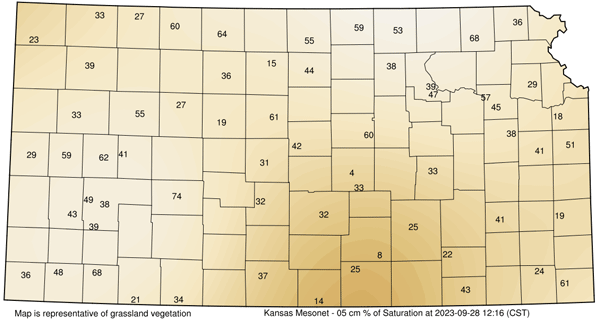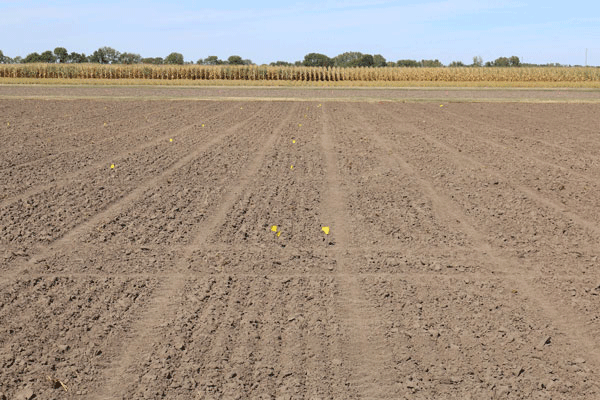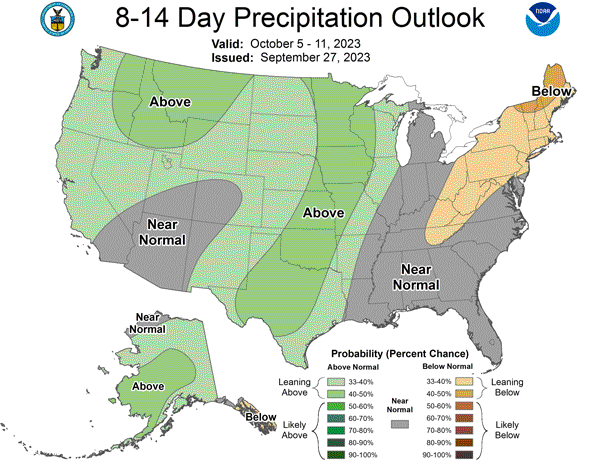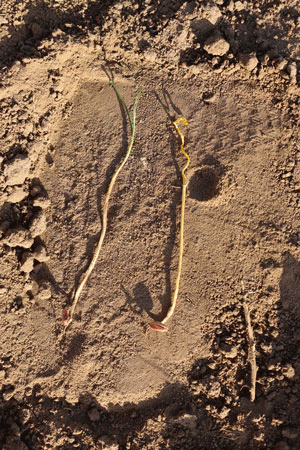Several areas of Kansas are still experiencing drought conditions. Topsoil conditions are now very dry in many areas of Kansas (Figure 1). For wheat yet to be planted in these areas, producers are left with a few options.

Figure 1. Topsoil moisture conditions at 2 inches (5 cm) reported as % saturation at the 5cm depth on September 28, 2023. Map by Kansas Mesonet found here: (https://mesonet.ksu.edu/agriculture/soilmoist).
Option 1: “Dust in” the wheat
Producers can choose to “dust in” the wheat at the normal seeding depth and normal planting date and hope for rain (Figure 2). Some farmers may consider planting it shallower than normal, but this could increase the potential for winterkill or freeze damage. Planting the wheat crop at the normal depth and hoping for rain is probably the best option where soils are very dry. The seed will remain viable in the soil until it gets enough moisture.

Figure 2. Wheat dusted in near Belleville in October 2015. Photo by Romulo Lollato, K-State Research and Extension.
Before planting, producers should look at the long-term forecast and try to estimate how long the dry conditions will persist. The current short-term outlook (8 to 14-day) suggests above-normal precipitation is favored statewide (Figure 3).

Figure 3. The precipitation outlook was issued on September 27, 2023, for the next 8-14 days (Oct. 5-11). Source: CPC.
Precipitation chances are increasing for much of the state at the beginning of October. However, if this rain doesn’t materialize or is more isolated in nature, this will push planting dates to the back end of the optimal planting range. Should this occur, producers should treat the fields as if they were planting later than the optimum time, as the emergence date will be delayed. Rather than cutting back on seeding rates and fertilizer to save money on a lost cause, producers should increase seeding rates, consider using a fungicide seed treatment, and use a starter phosphorus fertilizer to improve early season development. However, producers should be cautious with in-furrow nitrogen or potassium fertilizers as these are salts and can make it more difficult for the seed/seedling to absorb water needed for germination. The idea is to ensure the wheat gets off to a good start and will have enough heads to have good yield potential, assuming it will eventually rain and the crop will emerge late. Wheat that emerges in October may still hold full yield potential, but wheat that emerges in November almost always has fewer fall tillers and, therefore, can have decreased yield potential.
There are some risks to this option. First, a hard rain could crust over the soil or wash soil off planting ridges and into the seed furrows, potentially causing emergence problems - although heavy rain events are more likely to occur during summer months than in the fall. Another risk is the potential for wind erosion if the field lies unprotected with no ridges. Also, the wheat may not come up until spring, so it may have been better not to plant the wheat at all and plant a spring crop instead. In fact, not planting wheat and allowing soil moisture to build for a summer crop planted next spring is an option. If the wheat fails to emerge, then there would be little difference in soil moisture whether planted or not. If the wheat crop fails and a spring crop is planted, consider herbicide use and plant back restrictions.
Probably the worst-case scenario for wheat planted into dry soils would be if a light rain occurs and the seed gets just enough moisture to germinate but not enough for the seedlings to emerge through the soil or to survive very long if dry conditions return. Once the coleoptile extends to the soil surface, the plant must have enough moisture to continue growth otherwise, it will perish. This situation may be worsened if producers are planting wheat following a summer crop such as corn, soybean, or sorghum, which depleted subsoil moisture through late summer. Without subsoil moisture to sustain growth, the wheat stand can be completely lost. If late October brings cooler temperatures, dusting wheat in becomes a more interesting option as soil moisture from a possible rainfall event could be stretched further.
Option 2: Plant deeper than usual into moisture with a hoe drill
Planting deeper than usual with a hoe drill can work if the variety to be planted has a long coleoptile, the producer is using a hoe drill, and there is good soil moisture within reach. The advantage of this option is that the crop should come up and make a stand during the optimum time in the fall. This could potentially keep the soil from blowing.
The main risk of this option is poor emergence. Deep-planted wheat normally has below-normal emergence, so a higher seeding rate should be used. Any rain that occurs before the seedlings have emerged could add additional soil into the seed furrow, making it even harder for the coleoptile to reach the soil surface. Any time you increase the seeding depth, the seedling will have to stay within the soil that much longer before emerging through the soil surface.
Delayed emergence leads to more potential for disease and pest problems. Additionally, deep-planted wheat generally results in reduced tillering and, consequently, a reduced number of heads, which directly reduces the yield potential of the crop. It’s possible that the wheat would get planted so deep that it would germinate but never emerge at all, especially if the coleoptile length is too short for the planting depth (Figure 4). Generally speaking, it’s best to plant no deeper than 3 inches with most varieties. It is also important to remember that ridges formed by narrow press wheels can make the effective planting depth much deeper if the seed furrows fill in during a heavy rainfall event.

Figure 4. Deep-planted wheat can result in variable stands depending on whether the coleoptile of the plants reaches the soil surface (plant on the left) or not (plant on the right). In cases where the coleoptile does not reach the soil surface, chances are that the first true leaf will emerge below ground and perish with an accordion-like format. Photo by K-State Research and Extension.
Option 3. Wait for rain before planting
To overcome the risk of crusting or stand failure, producers may decide to wait until it has rained and soil moisture conditions are adequate before planting. Under the right conditions, this would result in good stands, assuming the producer uses a high seeding rate and a starter fertilizer, if appropriate. If it remains dry well past the optimum range of planting dates, the producer would then have the option of just keeping the wheat seed in the shed until next fall and planting spring crops next year instead.
The risk of this option is that the weather may turn rainy and stay wet later this fall, preventing the producer from planting the wheat, while those who dusted in their wheat could have a good stand. There is also the risk of leaving the soil unprotected from the wind through the winter until the spring crop is planted.
Crop insurance considerations and deadlines will play a role in these decisions. Another consideration is to delay the bulk of nitrogen application until topdress time in the spring, as wheat does not require much nitrogen in the fall. This would defer expenses until an acceptable wheat stand is assured.
Romulo Lollato, Wheat and Forages Specialist
lollato@ksu.edu
Lucas Haag, Area Agronomist – Colby
lhaag@ksu.edu
John Holman, Cropping Systems Agronomist
jholman@ksu.edu
Christopher “Chip” Redmond, Kansas Mesonet
christopherredmond@ksu.edu
Tags: wheat dry soils Drought wheat planting